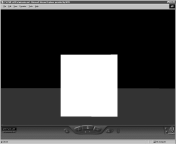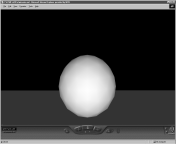Two invited presentations on seeing with sound by means of The vOICe were given in the
plenary opening session on "Sensory Substitution I: Visual Consciousness in Blind Subjects?"
(together with Paul Bach-y-Rita, and chaired by
![]() David Chalmers)
on Monday April 8, 2002, at the
David Chalmers)
on Monday April 8, 2002, at the
![]() Tucson 2002 conference
``Toward a Science of Consciousness'' at Tucson, Arizona, USA ("Tucson V", April 8 - 12, 2002).
This session was followed by a session on "Sensory Substitution II: Neural Plasticity in
Crossmodal Perception" with presentations by
Tucson 2002 conference
``Toward a Science of Consciousness'' at Tucson, Arizona, USA ("Tucson V", April 8 - 12, 2002).
This session was followed by a session on "Sensory Substitution II: Neural Plasticity in
Crossmodal Perception" with presentations by
![]() Mriganka Sur
and
Mriganka Sur
and ![]() Alva Noë.
Alva Noë.
Featured by Wired News on April 12, 2002, in the article "Red, Blue, Green and Other Sounds" by Mark K. Anderson.
![]()
|
CONFERENCE PROGRAM MONDAY – APRIL 8
PL1 Sensory Substitution I: Visual Consciousness in Blind Subjects? Chair: David Chalmers Bach-y-Rita, Paul , Tactile sensory substitution in blind subjects. 186Meijer, Peter, Fletcher, Pat,
PL2 Sensory Substitution II: Neural Plasticity in Crossmodal Perception Chair: Joseph Tolliver Sur, Mriganka, Rewiring cortex. 121Noë, Alva, Neural plasticity and consciousness: An enactive approach. 120 | |||
|
Abstract 187:
Seeing with sound for the blind: Is it vision?
It is technically possible to convert video into audio while preserving a significant amount of visual information in the resulting - usually highly complex - sounds. If blind people can learn to mentally reconstruct the visual content of live camera views, as now carried by these sounds or "soundscapes", then they might be able to "see" with sound. The prerequisite of getting visual information into the brain of blind people can nowadays be fulfilled, but it remains to be established to what extent this will amount to "vision" after prolonged immersive usage to allow the brain to adapt as far as it can.
The slides used in this presentation are available as a PDF file
|
Abstract 188:
Seeing with sound: A journey into sight
I first became aware of the Seeing with Sound project in 1999. I was primarily interested in the program’s capability to determine color. I wanted a means by which I could identify the colors of the clothing in my wardrobe. did not realize at that time the full potential of the program nor how it would eventually so dramatically impact my life.
The complete presentation by Pat Fletcher is available online as 16 Kbps streaming
| ||
These and other Tucson 2002 conference presentations are available on audio cassette from
![]() Conference Recording Service, Inc.
(
Conference Recording Service, Inc.
(![]() TSC22).
See also the web pages on the earlier invited presentations at SIGGRAPH 98,
VSPA 2001 and NIC2001. Related to the "qualia of vision" is also
the paper by Richard Gregory at Tucson III (1998) titled
TSC22).
See also the web pages on the earlier invited presentations at SIGGRAPH 98,
VSPA 2001 and NIC2001. Related to the "qualia of vision" is also
the paper by Richard Gregory at Tucson III (1998) titled
![]() "Flagging the Present Moment with Qualia".
A related philosophical theme is also "inverted qualia", which is about the experience of
differently mapped sensory inputs - and of key importance also for sensory substitution options.
"Flagging the Present Moment with Qualia".
A related philosophical theme is also "inverted qualia", which is about the experience of
differently mapped sensory inputs - and of key importance also for sensory substitution options.
|
|
The seventeenth-century philosopher William Molyneux, whose wife was blind, asked

 his friend John Locke whether a man born blind, in case he recovered his sight,
would be able to tell a cube from a sphere by sight alone, with previous sensory
experience with cube and sphere limited to touch. Molyneux thought the answer was
``No'', and Locke agreed (in
his friend John Locke whether a man born blind, in case he recovered his sight,
would be able to tell a cube from a sphere by sight alone, with previous sensory
experience with cube and sphere limited to touch. Molyneux thought the answer was
``No'', and Locke agreed (in
With visual objects observed as auditory objects via soundscapes from The vOICe, the situation
is different, and the answer would be ``Yes'': it is certainly possible to hear (and understand)
the roundedness of a sphere as compared to the more sudden sound transitions observed with the
squareness of an upright cube. What does that mean? Could it mean that seeing-with-sound is for
early-blind people actually closer to vision than having biological eyesight surgically restored?
It is certainly closer to vision than the phenomenon called "blindsight" in that the visual content
as encoded in sound can be consciously accessed. See also the sound samples in the Powerpoint file
|
The Tucson 2002 conference is covered in the book "Consciousness: An Introduction" (2004; e.g., page 267) by
![]() Susan Blackmore,
and briefly discussed in book chapter 4 (page 61)
Susan Blackmore,
and briefly discussed in book chapter 4 (page 61)
![]() Global
workspace theory of consciousness: toward a cognitive neuroscience of human experience by Bernard Baars,
in "The Boundaries of Consciousness: Neurobiology and Neuropathology", Steven Laureys (Ed.),
Progress in Brain Research, Vol. 150, pp. 45-53, 2005.
Perceptual and philosophical issues concerning The vOICe are also discussed in the book
Global
workspace theory of consciousness: toward a cognitive neuroscience of human experience by Bernard Baars,
in "The Boundaries of Consciousness: Neurobiology and Neuropathology", Steven Laureys (Ed.),
Progress in Brain Research, Vol. 150, pp. 45-53, 2005.
Perceptual and philosophical issues concerning The vOICe are also discussed in the book
![]() Seeing Red - A Study in Consciousness
(2006) by
Seeing Red - A Study in Consciousness
(2006) by ![]() Nicholas Humphrey.
Nicholas Humphrey.